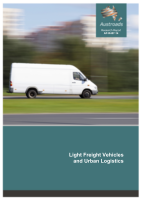Freight

- Publication no: AP-R457-14
- ISBN: 978-1-925037-58-6
- Published: 7 April 2014
- PDF (free) Download
The number of light commercial vehicles in Australia has increased at a faster rate than both population and state economic growth. This report examines the contribution of light commercial vehicles and light rigid trucks to the urban supply chain. It also considers their impact on traffic capacity, network congestion, the environment and road safety.
This project defined light freight vehicles (LFVs) as being a LCV or LRT which is used primarily for the carriage of freight. That is, LFVs transport goods from one location to another without adding further value. It collected traffic flow data from a number of sites during peak and off- peak periods on weekdays in two capital and two regional cities in New South Wales and Queensland.
Analysis found LFVs comprise 9.1% of more than 2,100 observed LCVs, and 77.3% of the 251 observed LRTs. These findings are substantially supported by the Melbourne Commercial Vehicle Video Study of 2012. LFVs comprise only 4.1% of all the traffic streams observed in four cities.
- 1. Introduction
- 1.1. Study Context
- 1.2. Study Purpose and Methodology
- 1.2.1. Study Purpose
- 1.2.2. Methodology
- 1.3. LFV Determination and Function
- 1.4. LFV Policy Implications
- 1.5. Further Work
- 2. Role of Light Freight Vehicles
- 2.1. The Passenger, Service and Freight Continuum
- 2.2. The Light Freight Vehicle Issue
- 2.3. Light Commercial Vehicle Growth
- 2.4. Defining Light Freight Vehicles
- 3. Determining Light Freight Vehicle Role
- 3.1. Traffic Surveys
- 3.2. Vehicles Comprising LCVs and LRTs
- 3.3. Observed Vehicle Survey Results
- 3.4. Light Freight Vehicle Survey Results
- 3.4.1. Melbourne Commercial Vehicle Video Survey
- 3.5. Light Freight Vehicle Usage
- 3.5.1. State Variations
- 3.5.2. City Variations
- 3.5.3. Locational Variations
- 3.5.4. Time of Day Variations
- 3.6. Company Surveys
- 3.7. Jurisdictional Surveys
- 4. Light Freight Vehicle Impacts
- 4.1. Traffic Capacity Effects
- 4.1.1. Approach
- 4.1.2. Analysis
- 4.1.3. Forecasting Effects of LFVs on Traffic Stream Performance
- 4.2. Network Congestion Effects
- 4.2.1. Approach
- 4.2.2. Results
- 4.2.3. Marginal Impacts of LFVs on AM Peak Congestion
- 4.3. Environmental Impacts
- 4.3.1. Fuel Consumption and Emissions
- 4.4. Social Impacts
- 4.4.1. Traffic Stream Noise
- 4.4.2. Road Safety Impacts of LFVs
- 5. Light Freight Vehicle Policy Implications
- 5.1. LFV Policy Development Context
- 5.2. LFV Policy Development
- 5.2.1. Vehicle Performance and Network Effects
- 5.2.2. Vehicle Type and Usage
- 5.2.3. LFV Emissions
- 5.2.4. Road Safety
- 5.2.5. Traffic Stream Noise
- 5.2.6. Parking for LFVs and light servicing vehicles
- 5.3. LFVs and Central Business District Servicing
- 5.3.1. LFV and CBD Issues
- 5.3.2. Policy, Planning and Management Overview
- 5.3.3. CBD Findings and Next Steps
- References
- Appendix A Traffic Observation Site Details
